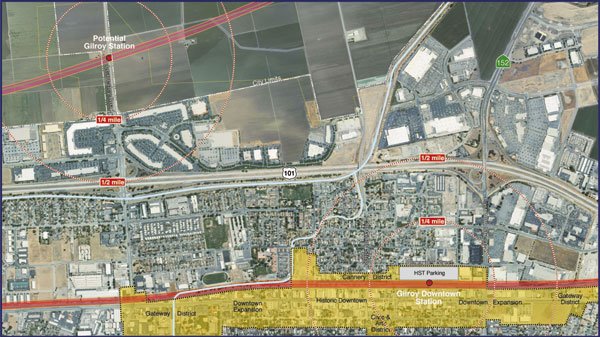The California High-Speed Rail Authority will continue to
consider a trenching option for a bullet train through Gilroy,
after the authority’s board discussed whether to eliminate the
option during its Thursday meeting.
The California High-Speed Rail Authority will continue to consider a trenching option for a bullet train through Gilroy, after the authority’s board discussed whether to eliminate the option during its Thursday meeting.
Staff had recommended that putting the tracks underground be scratched because of added costs. However, Authority board member and former Santa Clara County Supervisor Rod Diridon said trenching was important to Gilroy residents. Due to his lobbying, the board did not eliminate the trenching option.
“What happened was really a tribute to (the Gilroy Dispatch’s) editorial board meeting last week,” Diridon said after the meeting.
Both editorial board members and local council members favored trenching over aerial tracks, he said.
The 800-mile California High Speed Rail system will have routes from San Diego to Sacramento and to the Bay Area, transporting passengers at speeds of up to 220 mph. A 123-mile stretch from Merced to San Jose would run through the Pacheco Pass with a proposed station in Gilroy. Riders could travel the distance of the route in 45 minutes.
Dave Mansen, regional manager for Parsons Corporation and regional team manager for the Authority, said that trenching the tracks near Gilroy would add as much as 20 percent to the costs of the San Jose-to-Merced portion of the project. Although the entire project is expected to cost $45 billion, specific costs of the various project alternatives have yet to be determined.
The Authority board, which met Thursday in Sacramento, spent hours discussing rail alternatives in the Central Valley and Bay Area.
Staff recommended rejecting separate station tracks looping from U.S. 101 to a downtown Gilroy station, as it would add 30 percent to the cost of the Morgan Hill-Gilroy alignment.
They opted instead to run tracks east of the Union Pacific railroad tracks for the Bay Area-to-Central Valley portion.
Other viable options recommended by staff included running the tracks east of U.S. 101 near Gilroy, which would eliminate 10 more homes than the UP alignment, or running them through downtown Gilroy.
Further north, staff said the authority could consider running the tracks along U.S. 101 near Morgan Hill, allowing for wildlife crossings in the Coyote Valley area.
While Diridon recommended trenching near Gilroy, he disapproved of tunneling the tracks in San Jose, saying such measures would be logistically challenging and cost-prohibitive.
His comment came after a couple of San Jose residents advocated for the underground option. Diridon said he did not want to give people false hopes.
“Let’s concentrate on the (alternatives) that are viable,” he said.
After the meeting, Diridon said tunneling in San Jose could multiply costs of the project several times because of the complexities involved.
Meanwhile, the Authority will have some work to do before implementing any alternative. The board voted to decertify its environmental impact report, after Sacramento Superior Court Judge Michael Kenny ruled in August that portions of the environmental impact report for the Bay Area-to-Central Valley route would need to be rewritten.
Specifically, the rail authority needs to conduct additional studies on the impacts of the vibrations of trains running at full speed through urban areas.
Kenny also ruled that the Authority must consider alternatives in case Union Pacific does not allow them to use their right of way.
The Sacramento-based California Rail Foundation, one of several groups that sued the rail commission for choosing the Pacheco Pass Route, says the environmental process for that route would be more daunting the second time around. As a result, the group’s president, Richard Tolmach, announced Wednesday that he thought the board would rescind the Pacheco Pass route entirely.
Tolmach said the Authority must find a new route between San Jose and Gilroy because the court found that a route identified by the Authority had inadequate space for tracks.
“This time the people of Gilroy and Morgan Hill know that trains are coming through town at 220 mph,” Tolmach said.
Instead, the Authority board favored doing away with the environmental document but retaining a Pacheco Pass route.
“It was a real, real swift discussion – a real unsexy thing,” Authority spokesman Jeff Barker said.
He thought that Tolmach did not even believe that the board would rescind the Pacheco Pass route.
“In my business, that’s what we call spin,” he said. “We’re by no means starting from scratch on this thing.”
Barker predicted that the rail authority would complete the portions of the document it must rewrite by February or March.
At that time, staff will have more detailed information on each of the alternatives, including trenching in Gilroy.
Most Gilroy City Council members indicated during a study session last month that they favored having a high-speed rail station in town, although they wanted it trenched.
Mayor Al Pinheiro said Wednesday that the council on Monday will discuss a joint resolution with Morgan Hill’s council that supports a high-speed train station in Gilroy and U.S. 101 alignment through Morgan Hill.
While Pinheiro said there has been some opposition to the route in northern Santa Clara County, that’s certainly not the case in Gilroy or Morgan Hill, he said.
Diridon said Pinheiro was a supporter of the project early on, and he has appreciated the council’s input.
“I’ve especially enjoyed the mayor’s thoughtfulness and courage on this issue,” he said.
At the same time, he noted that most cities slated to include downtown stations, with the exception of Gilroy, have redevelopment agencies that can capture tax revenues generated from property value increases in the area.
As a citizen and as a former Santa Clara County supervisor, he recommended that Gilroy do the same.














